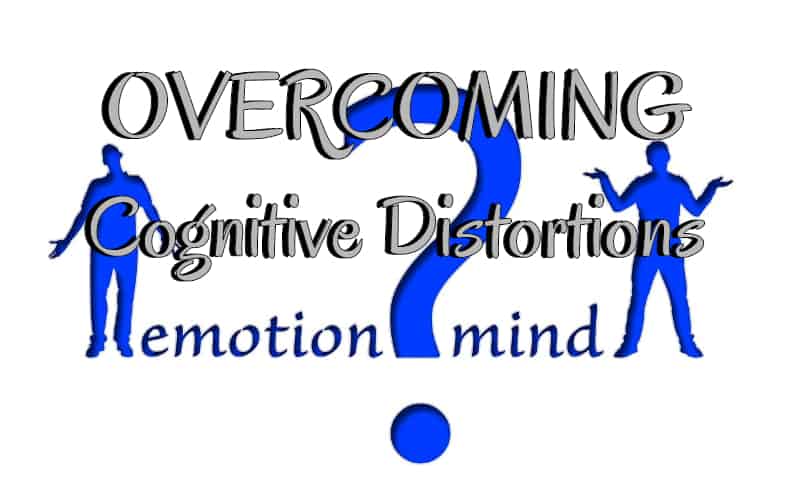10 Methods to Overcome Cognitive Distortions

In my previous article on Cognitive Distortions, I went in-depth on cognitive distortions and their impact on our daily living. How different cognitive distortions can affect the way we think, feel, and act.
In this article, we will tackle how to overcome the 16 different cognitive distortions previously discussed. John M. Grohol, Psy.D, in his article 10 Proven Methods for Fixing Distortions, gave us the following methods.
10 Methods to Overcome Cognitive Distortions
1. Identify the Cognitive Distortion
This is the first step; we identify the cognitive distortion in our daily thinking, examine them to determine the type of cognitive distortion so we can start changing them.
2. Examine the Evidence
A comprehensive assessment and evaluation of experience enable one to determine the basis of these distorted thoughts. We need to be able to set apart facts from opinions to help us figure out if they are indeed elements of cognitive distortions, what to focus on, and what we need to do.
3. Double Standard Method
Merriam-Webster defines Double Standard as a set of principles that applies differently and usually more rigorously to one group of people or circumstances than to another. When we judge ourselves, we typically use a different standard over others. We usually are more rigid on ourselves than others.
We need to instead treat ourselves with the same standard that we judge others. Use one standard. Talk to yourself as if you are talking to a friend. Say the same words to yourself that you would say when trying to uplift and encourage a friend.
4. Thinking in Shades of Gray
Some things in life, we can use look at them as black or white, but this is not applicable all the time, and we need to see the gray areas of an issue, a dilemma, or a predicament. Not everything is either right or wrong. We need to study, consider, and evaluate things through ranges, through scales, through percentages.
Let’s say a project is not finished. We cannot judge as a project is successful or not just because it is not completely finished. Judge it by saying it is 75% finished. Or when patients are asked in the hospital if they have pain or no pain. Instead, they are being asked, “from a scale of 1 to 10, how bad is your pain?
5. Experimental Method
It is using the same kind of method that science uses to test a hypothesis. We have variables, and we manipulate said variables to determine if changes in one variable cause changes in another variable. It uses to control and random sampling of various selected variables to test a hypothesis.
Many problems in our life could have been solved if we asked the questions first before making a judgment. We need to test things first before concluding. Seeking the facts first before making a decision.
6. Survey Method
We seek answers by asking other people’s opinions who are in a similar situation, whether our thoughts and attitudes are true and realistic. We substantiate our feelings by verifying, validating, and collaborating with others to make a fair and honest judgment.
We become objective, not subjective.
7. The Semantic Method
Unwritten rules on our behaviors by saying words like “I should,” which are not helpful and unkind because we are imposing things that may be unrealistic or impractical. Instead, substitute with “It would be nice if…”
This semantic difference works wonders in our mind, as was top “should-ing” ourselves to death and looking at the world in a distinct, more positive way.
8. Definitions
Labels and descriptions are just that and should not define anybody or anything. There are so many other considerations to be made when delving into any subject matter. There are many factors to assess before we can make a final choice, judgment, or decision. Nothing in this world is as it seems at first glance, and there is always something more to learn. Nothing is that simple.
9. Re-attribution
In re-attribution, we determine external factors and other individuals that contributed to the problem or event. By reviewing the issue or event, we look at things objectively and assign responsibility accordingly. You’re not trying to draw away the blame, but ensuring we are not blaming ourselves entirely for something that wasn’t entirely our fault.
10. Cost-Benefit Analysis
A cost-benefit analysis will help us determine what a person is gaining from distorted thinking, feeling inadequate and inappropriate behavior. If, after doing this, we can see the pros and cons and conclude that distorted thinking is not beneficial at all, it will be easier to overcome an illogical belief.
Why Is This Important
Knowing the different cognitive distortions is the first step. Recognizing them is the second; overcoming them by using the various methods is the third step, and evaluating if the technique used worked or not so we can try another one is the fourth step to begin the process again. Like anything in life, it is a process, a series of trials and errors. Therein lies the beauty of life. Never is it constant. Sometimes you’re up; sometimes you’re down. So many things can happen; change is inevitable. We are never a finished project. We can always be better. We can always improve. We are always a work in progress.
Source
https://psychcentral.com/lib/fixing-cognitive-distortions/





Write more, thats all I have to say. Literally, it seems as though you
relied on the video to make your point. You clearly
know
what youre talking about, why waste your intelligence
on just posting videos to your blog when you could be giving us
something informative to read?
I am actually thankful to the holder of this site who has shared this impressive article
This design is wicked! You certainly know how to keep a reader entertained.
Between your wit and your videos, I was almost moved to start
my own blog (well, almost…HaHa!) Great job. I
really enjoyed what you had to say, and more than that, how you presented it.
Too cool!
fantastic issues altogether, you simply received a brand new reader. What may you suggest about your publish that you made some days ago? Any positive?|
naturally like your website however you have to test the spelling on quite a few of your posts. Several of them are rife with spelling issues and I in finding it very bothersome to tell the reality nevertheless I will certainly come back again.|
I have been surfing online more than three hours today, yet I never found any interesting article like yours. It’s pretty worth enough for me. In my opinion, if all site owners and bloggers made good content as you did, the net will be much more useful than ever before.|
What’s up friends, its great post about teachingand fully defined, keep it up all the time.|
Thank you for any other informative blog. Where else may just I get that kind of information written in such an ideal method? I have a project that I’m simply now working on, and I’ve been on the look out for such information.|
You have made some decent points there. I checked on the internet for more information about the issue and found most people will go along with your views on this site.|
I’m not sure where you’re getting your information, but good topic. I needs to spend some time learning more or understanding more. Thanks for wonderful information I was looking for this information for my mission.|
Your Short article was extremely valuable. Thank you for this valuable information.
Hi! I know this is kinda off topic but I was wondering which blog platform are you using for this site?
I’m getting tired of WordPress because I’ve had issues with
hackers and I’m looking at options for another platform.
I would be great if you could point me in the direction of a
good platform.
We’re a group of volunteers and opening a new scheme in our community. Your website offered us with valuable information to work on. You have done a formidable job and our whole community will be grateful to you.
Your style is really unique in comparison to other folks I have read stuff from.
Many thanks for posting when you have the opportunity, Guess I’ll just bookmark this site.
My homepage – 2022